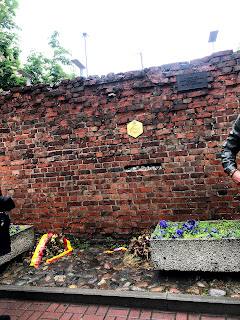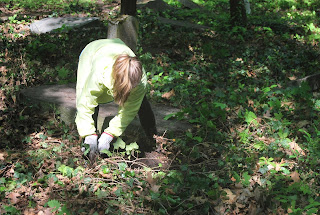After a good nights rest, a yummy breakfast, and some coffee, we were off to our first day working at the cemetery. To get there, we had about a 7-minute walk to a tram station, where we rode for probably 15 minutes, then a short walk to the entrance. The tram is a popular form of transportation in Poland and is known for being very efficient. I was able to sit and observe the buildings and cars that drove by. All except one of the cars that I have seen have a manual shift, which was surprising to me because, in the States, most of ours are automatic.
 |
| Our Plot before we started working on it |
We got to the cemetery and it was amazing. It's a huge area with huge trees. The front of the cemetery has a lot of new, polish catholic styled gravestones, whereas toward the middle and back was more german influenced headstones. While we waiting for the groundskeeper, Dr. WcWhirter gave us a quick tour of the fields. A German restoration group that works to restore Jewish cemeteries and other similar acts to work toward making amends for the Holocaust is also working at the same cemetery. After our tour, our groundskeeper led us to the field that we will be working on over the course of the next 3 days. We worked on uncovering brush from the headstones for about an hour and a half before breaking for lunch, then we worked for another two hours. Over our three and a half hours, we had 30 people picking up sticks, branches, and what should be considered small trees to clean up our field. Over these three and a half hours, we were able to uncover around 150 headstones that were facing up and had photos taken. There were also many tombstones that were facedown, which we were unable to take pictures of because a tripod is needed to lift them.
 |
| Our Plot after day one in the cemetery (3.5 hours of work) |
** I would like to note that my pictures capture a very small part of our plot. Our plot is very large and at first, it almost all looked like the first picture, but after our work, it looked like the second throughout.**

After working at the cemetery, we went back to the hotel and had an hour or so to get off of our feet before having a group session on our survivor memoirs. During this break I laid down, attempting to reenergize myself and give my back a break. At our group session, we got into our memoir groups (
Surviving Auschwitz, Dry Tears, All But My Life, and Seed of Sarah) to discuss the book and the significant parts of it. My memoir was
Seed of Sarah, about a girl who was a young teenager at the time the Nazis invaded Hungary and what she went through. My group talked about how she wrote this book differently than other memoirs we've read in that she told us how she used to never talk about her experiences and it was after giving a talk of her life that she couldn't help but start writing. She also looked more at the human side of the decisions her perpetrators were making, rather than simply talking only about all of the hardships she experienced. There was a large trend of sticking with her family during that period and at the end of the book, there is a lot of mention of Holocaust Deniers as well as people she grew up with not talking about what she went through. We thought the author's intention was to show how it is something that needs to be talked about, since so many people lost so much, if not, everything.

We were finally able to eat after the long day at the completion of this session. I went to a restaurant called Umami and got Pad Thai, which was very yummy. After dinner, we got ice cream rolls (a trendy food thing) which was a first for all of us! It was good, but not much different than normal ice cream. Finally, we went to a souvenir store and then walked back to the hotel for a good nights rest.
 |
| The first headstone I uncovered |
The first full day of activity was very interesting. The work was very hard in the cemetery, but it was unreal how many stones we were able to uncover. I personally had to have uncovered at least 12. Coming into this trip, I was sure we would be finding some headstones, but I didn't think we would find as many as we did. A lot of the time I would be digging out one and see part of another right next to it! It was exciting to put a name to the stone being uncovered, and even more so to think about what their lives were like. Most of the stones I uncovered died around 1935 and 1936. There is still a lot to get done at our plot and I'm sure we are still missing some gravestones so tomorrow will be another exciting day.
 After working at the cemetery, we went back to the hotel and had an hour or so to get off of our feet before having a group session on our survivor memoirs. During this break I laid down, attempting to reenergize myself and give my back a break. At our group session, we got into our memoir groups (Surviving Auschwitz, Dry Tears, All But My Life, and Seed of Sarah) to discuss the book and the significant parts of it. My memoir was Seed of Sarah, about a girl who was a young teenager at the time the Nazis invaded Hungary and what she went through. My group talked about how she wrote this book differently than other memoirs we've read in that she told us how she used to never talk about her experiences and it was after giving a talk of her life that she couldn't help but start writing. She also looked more at the human side of the decisions her perpetrators were making, rather than simply talking only about all of the hardships she experienced. There was a large trend of sticking with her family during that period and at the end of the book, there is a lot of mention of Holocaust Deniers as well as people she grew up with not talking about what she went through. We thought the author's intention was to show how it is something that needs to be talked about, since so many people lost so much, if not, everything.
After working at the cemetery, we went back to the hotel and had an hour or so to get off of our feet before having a group session on our survivor memoirs. During this break I laid down, attempting to reenergize myself and give my back a break. At our group session, we got into our memoir groups (Surviving Auschwitz, Dry Tears, All But My Life, and Seed of Sarah) to discuss the book and the significant parts of it. My memoir was Seed of Sarah, about a girl who was a young teenager at the time the Nazis invaded Hungary and what she went through. My group talked about how she wrote this book differently than other memoirs we've read in that she told us how she used to never talk about her experiences and it was after giving a talk of her life that she couldn't help but start writing. She also looked more at the human side of the decisions her perpetrators were making, rather than simply talking only about all of the hardships she experienced. There was a large trend of sticking with her family during that period and at the end of the book, there is a lot of mention of Holocaust Deniers as well as people she grew up with not talking about what she went through. We thought the author's intention was to show how it is something that needs to be talked about, since so many people lost so much, if not, everything.

 After working at the cemetery, we went back to the hotel and had an hour or so to get off of our feet before having a group session on our survivor memoirs. During this break I laid down, attempting to reenergize myself and give my back a break. At our group session, we got into our memoir groups (Surviving Auschwitz, Dry Tears, All But My Life, and Seed of Sarah) to discuss the book and the significant parts of it. My memoir was Seed of Sarah, about a girl who was a young teenager at the time the Nazis invaded Hungary and what she went through. My group talked about how she wrote this book differently than other memoirs we've read in that she told us how she used to never talk about her experiences and it was after giving a talk of her life that she couldn't help but start writing. She also looked more at the human side of the decisions her perpetrators were making, rather than simply talking only about all of the hardships she experienced. There was a large trend of sticking with her family during that period and at the end of the book, there is a lot of mention of Holocaust Deniers as well as people she grew up with not talking about what she went through. We thought the author's intention was to show how it is something that needs to be talked about, since so many people lost so much, if not, everything.
After working at the cemetery, we went back to the hotel and had an hour or so to get off of our feet before having a group session on our survivor memoirs. During this break I laid down, attempting to reenergize myself and give my back a break. At our group session, we got into our memoir groups (Surviving Auschwitz, Dry Tears, All But My Life, and Seed of Sarah) to discuss the book and the significant parts of it. My memoir was Seed of Sarah, about a girl who was a young teenager at the time the Nazis invaded Hungary and what she went through. My group talked about how she wrote this book differently than other memoirs we've read in that she told us how she used to never talk about her experiences and it was after giving a talk of her life that she couldn't help but start writing. She also looked more at the human side of the decisions her perpetrators were making, rather than simply talking only about all of the hardships she experienced. There was a large trend of sticking with her family during that period and at the end of the book, there is a lot of mention of Holocaust Deniers as well as people she grew up with not talking about what she went through. We thought the author's intention was to show how it is something that needs to be talked about, since so many people lost so much, if not, everything. 





Comments
Post a Comment